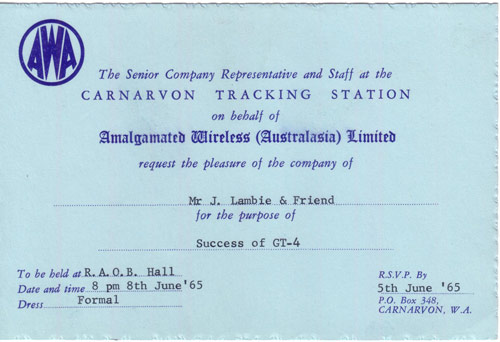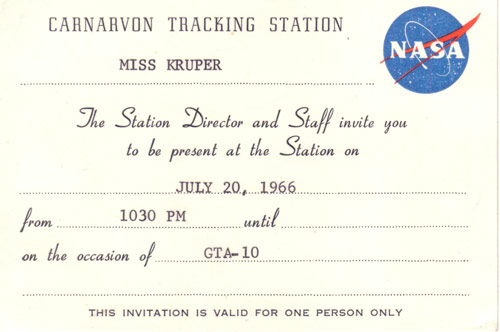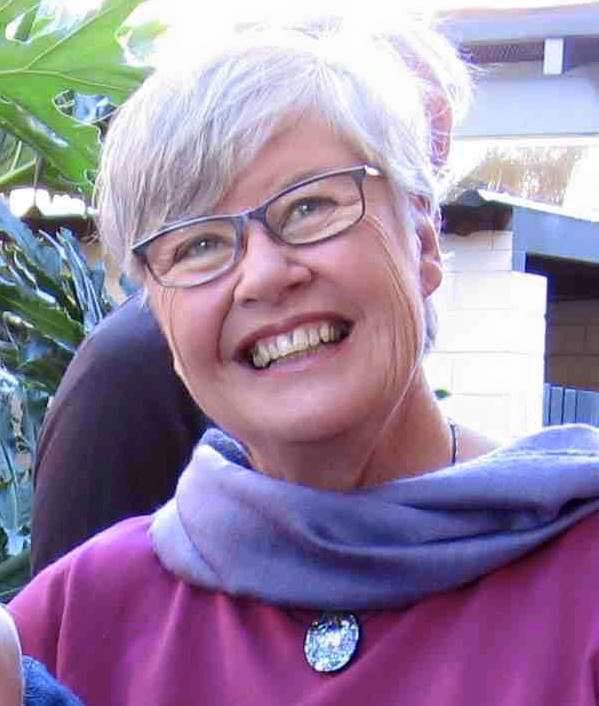Karin with students at the Carnarvon School.
Photo: John Lambie.
Karin’s story
by Karin Lambie (nee Krupavicius aka Krupa)
1943 – 2012
Karin with students at the Carnarvon School. Photo: John Lambie. |
While fresh out of Teachers College, going to Carnarvon in the 60’s and teaching in a District High School was certainly a shock to my naïve city bred system.
I arrived at the Perth airport in February, thinking I was well prepared for long distant travel; the young sophisticate out to make a good impression, dressed in a pale green ‘Chanel’ type suit, white high heels and pale beige sheer stockings attached to a suspender belt. My hair styled into a gleaming blonde and then fashionable ‘French Roll’. Well… having settled down on the aircraft to give the appearance that I had done loads of travelling by air to date, when inside I was excited and curious about what my future in the north west held.
The plane made a scheduled stop at Gascoyne Junction and we were asked to disembark while there was some technical stuff happening. What a shock! I felt like I had stepped into a fan forced oven. I could have fried eggs on the aircraft wing. When we were allowed back on to the DC3 aircraft it was straight into the aircraft toilet, off with the suspenders, stockings and lacy camisole. This was my first taste of the reality of ‘beyond the 26th parallel’. I had learnt that loose and low was the way to go. Loose dresses to encourage the breeze and low heeled shoes on the gravely paths were de-rigour.
On arrival at Carnarvon airport I stood on the tarmac waiting for a friendly welcome. Nope! None! The taxi driver took me to the school where (Mr Max Piggott) the headmaster looked somewhat surprised and apologised for forgetting my arrival time. Then, without turning a hair, he asked if I could take charge of ‘my class’ then and there. It transpired that the students had been free to play on the school oval awaiting my arrival for the whole week. It was Friday afternoon and I had nowhere to stay that night. So I declined to take the class and suggested that I look for somewhere to stay (something he and I had discussed on the phone earlier in the week resolving that he would look into it). My high expectations started to dissolve and I was thinking about the next flight home.
The headmaster redeemed himself quickly and organised for me to share a room with another teacher in a private home in North Carnarvon till I could look around for something more private and still affordable on a teacher’s salary. Accommodation was very scarce because the Space Tracking Station had come to Carnarvon and they could not build houses quickly enough to accommodate all the international and interstate personnel and their families. Over the three years my accommodation included shared rooms, short-term house sitting, a caravan and a hotel room. Things are different today where the Education Department provides appropriate housing for most teachers in country areas.
Karin beside the Gemini Fountain at Carnarvon Tracking Station, 1966. Photo: John Lambie. |
On Monday I was at my classroom door to welcome the 31 freedom loving students to sit at their desks and be assessed for core competencies. Can you imagine the huge range of competencies I discovered in this group? One third of the year three class was from ‘the plantations’, children of market farming families who turned out to be mainly Portuguese and Italian. One third was Indigenous, students from the ‘mission’ and the ‘reserve’ both very different in attitude, experience and both from out of town, all these children coming to school on a bus. The rest were children from the town (permanent residents and itinerants), including children from the stations surrounding Carnarvon and the children from the ‘tracking station’ families.
You can imagine the dress code of this fairly eclectic group. Children new from Europe soon chose to discard their sox and shiny shoes in favour of sandals and shirts out. I encouraged the anonymity of the school uniform where I could (sometimes raiding the lost property box) in the name of equality. The school ground babble was sprinkled with a most varied array of accents and turns of phrase. We all learned new ways of expressing ourselves. There were few ‘tracking station’ children in our school, and none in my class, most families had young pre schoolers, like eastern staters John and Lyn Nugent who brought with them a very young son Michael. Their baby daughter Louise was born in Carnarvon.
I displayed a very serious face at first (just as I was taught in college) keeping the students busy, changing topics to stall boredom and keeping tight control by learning names quickly. At the front of the room above the blackboard was a portrait of the Queen wearing a yellow silk dress with wattle flowers on her shoulder. In this portrait the classroom behind me was reflected. The children were stunned when I spoke to them without turning around and while writing on the blackboard. They thought I had a third eye in my French roll. I quickly gained a reputation for ‘knowing’ throughout the school. On the Wednesday (pension day) I was bemused by a row of dark faces peering into the high louvered classroom windows at me, to quickly disappear when I went to the door to say hello. When I opened the door I saw the last flick of skirt and heels disappear around the corner. The Indigenous parents were VERY shy. I was to find out later that many of the children in my class had told their parents that their new teacher was a serious old lady with spectacles and white hair in a bun. Even the parents I met in the ‘Carnarvon Repertory Club’, mostly from the professional town jobs and tracking station workers, expressed surprise when meeting me. I was twenty years old and thereafter often wore a ponytail hairdo (smiling to myself each time I put in multi coloured ribbons). One of my co-actors was Richard Simons from England who worked at the Tracking Station and whose children attended the local Catholic School.
Part of a programme for a production of the Carnarvon Repertory Club. Scan: John Lambie. |
Teaching in this remote, adventurous and exciting location gave me opportunities that would be difficult to pursue in today’s litigious society with public liability insurance concerns. The children in my class had the opportunity to write their own reading material in their own words (somewhat edited with my help) because there were no reading materials that they could easily relate to. Dick and Dora did not inspire. They rode on sheep’s backs on our many visits to out-lying stations on research missions into station life. We learnt about tracking lizards in the sand (good eating) and what seeds to collect – from the indigenous students in our class. We ate prawns straight from the prawn boats (two dads were prawn fishermen), watermelons from the market gardens, kangaroo from the hunting dad and all in the name of on-the-spot learning, sound researched and recorded data in the form of projects, co-operative group activity and independence training. The three years in the classroom teaching the children of Carnarvon were happy ones for me. The student diversity presented a huge challenge and pleasure all in one.
The teaching staff was friendly and social interactions were planned on a weekly basis. Everyone was encouraged to participate. Parties, golfing tournaments, picnics and the movies kept us amused, sane and became our family in this remote place. The hotels were the only public places that had air conditioning and were well patronised. Teachers were considered professional itinerants as were the Bank, PMG, Post office, nurses, main roads, native welfare and Tracking Station personnel. The local people often resisted social time investment due to always being left behind as people left. However the local business people enjoyed our visits and were very welcoming.
The Tracking Station afforded the opportunity for many more formal social occasions. The regular town population had never seen such goings on. Invitations were sought after by all, and having a contact on the inside helped.
Karin at the Gemini Fountain at Carnarvon Tracking Station, 1966. Photo: John Lambie. |
I received an invitation to the GT4 Ball at RAOB Hall 8 June 1965 as a partner of John Lambie. (Who was my own true love and later became my husband.)
Invitation to Mr J. Lambie and Friend. |
I was introduced to, and invited to dance with, Lewis Wainwright, who asked what part of England I came from? My accent was a little different having learned English at primary level. Cheekily I replied ‘Petticoat Lane’ (seemed romantic at the time), I received a glance askance from the Station Director and was dropped like a hot potato. Later I discovered that Petticoat Lane was where the London fish-markets were. We had a laugh about it later.
Later still I received another invitation for myself from the Station Director and Staff to the Carnarvon Tracking Station on July 20 1966 for occasion of GTA 10. The occasion was well organised, exciting dazzling technology gee wizz and space history in the making and on the spot.
Invitation to Miss Krupavicius. |
Karin and her fiancé John Lambie at the wedding of Pete and Bea Peterson in Carnarvon. Photo: Hamish Lindsay. Scan: Colin Mackellar. |
Karin Lambie in 2011. In loving memory of Karin Lambie, 1943 – 2012. Photo: Roxanne Lambie. |
Note: Karin wrote this in 2005 for possible inclusion in the book “Carnarvon and Apollo” by Paul Dench and Alison Gregg. It’s a privilege to be able to include it here.







